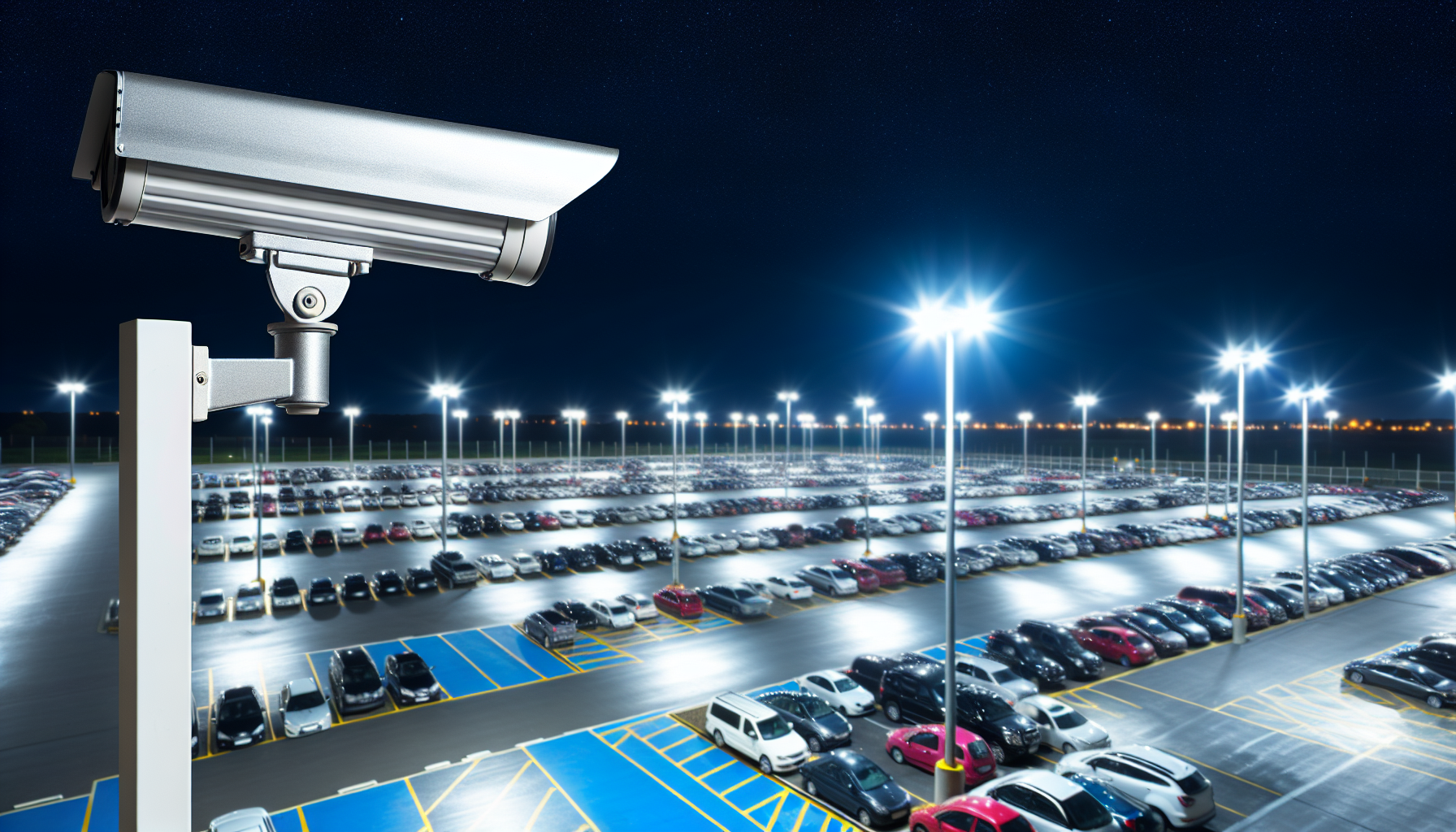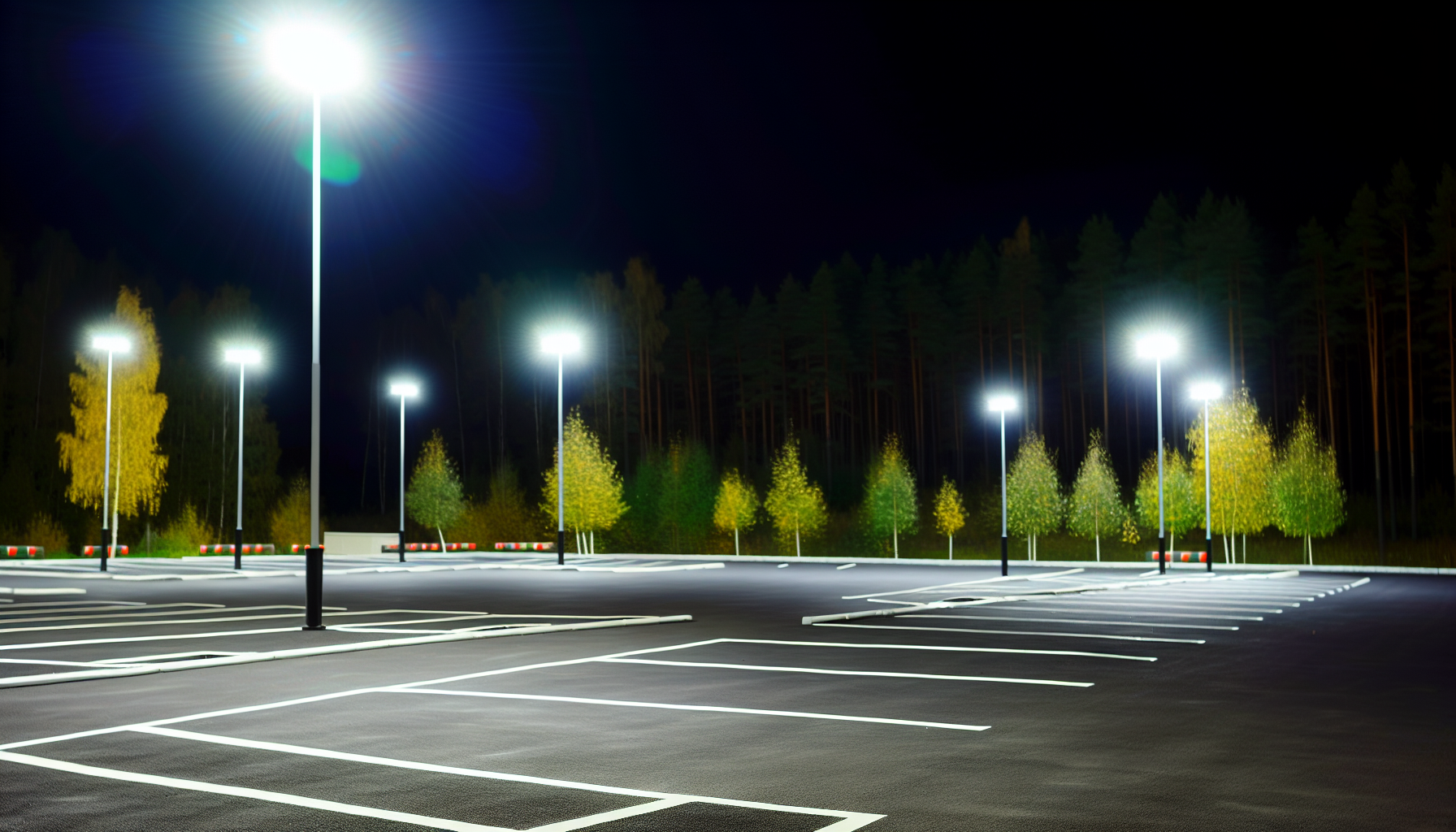Catalytic converter thefts are soaring due to their valuable metal content. With thefts performed swiftly and surreptitiously, how can you protect your vehicle? In this article, we’ll dive into the mechanics behind these thefts and introduce remote video monitoring and other robust security measures designed to safeguard your valuable car parts against this growing criminal trend.
Key Takeaways
- Catalytic converters are targeted for theft due to the precious metals they contain, with a surge in thefts correlating to an increase in global metal prices, making remote video monitoring a crucial deterrent.
- Remote video monitoring services, equipped with advanced features such as AI analytics and real-time threat detection, offer effective prevention of catalytic converter thefts while being cost-effective compared to physical security personnel.
- Additional protective measures to deter catalytic converter thefts include using anti-theft devices and marking converters for identification, as well as fostering community awareness and collaboration with local law enforcement.
Understanding Catalytic Converter Thefts
Catalytic converters form a vital part of your vehicle’s exhaust system. They are designed to:
- Filter out harmful byproducts in the exhaust gases
- Burn up harmful emissions, minimizing their impact on the environment
- Enhance the vehicle’s efficiency
But it’s not just their environmental role that’s important. Catalytic converters also contain precious metals like platinum, palladium, and rhodium, which makes them valuable for thieves.
In 2022 alone, a staggering 153,000 catalytic converters were stolen from vehicles in the U.S., with the global count of catalytic converter thefts reaching over 64,000 in the same year. Hence, the significance of video surveillance in combating these thefts is undeniable.
The Rising Trend of Catalytic Converter Theft
The high value of precious metals in catalytic converters is attracting thieves like bees to honey. The surge in thefts of catalytic converters is directly related to the rising demand for these metals. But can we prevent these break-ins?
Interestingly, fluctuations in global metal prices have a direct relationship with the occurrence of catalytic converter theft. The higher the prices of these metals, the more valuable the catalytic converters become, making them a lucrative target for thieves. But how do they manage to steal these converters?
How Thieves Steal Catalytic Converters
Gone are the days when thieves needed to spend a considerable amount of time to steal a car part. Today, thieves use battery-powered reciprocating saws to quickly remove catalytic converters from vehicles by accessing the underside of the car. And the most shocking part? They can steal a catalytic converter in under two minutes.
Certain vehicles are particularly vulnerable to catalytic converter theft. The Toyota Prius and the Ford F-Series pickup are popular targets. The Prius is targeted due to its higher precious metal content, while the Ford F-Series pickup is a common target due to the demand and easy accessibility of its catalytic converter.
Remote Video Monitoring as a Solution

Given the rapid nature of these thefts, a robust security system becomes fundamental. This is where remote video monitoring comes into play. Remote video monitoring provides:
- Continuous surveillance of your property
- Alerting security professionals to any suspicious activity
- Enabling interventions through live guards or two-way audio communication systems.
Remote video monitoring offers several benefits:
- It is effective in preventing crime before it happens
- It is cost-effective, offering continuous coverage at a reduced cost compared to hiring multiple security guards
- It reduces false alarms, potentially saving on fines.
With technological advancements, live video monitoring and remote video monitoring services are becoming more efficient. Top companies like VirtuGuard™ offer features such as real-time video feed, professional management of camera feeds for swift responses to incidents, and the utilization of cloud-hybrid video analytics systems for remote video surveillance.
Benefits of Remote Video Monitoring
The advantages of remote video monitoring are manifold. For one, it provides real-time remote surveillance, enabling operators to promptly respond to any incidents. Services like VirtuGuard™ offer live remote video monitoring with a live guard service for immediate security event response, ensuring that no corner of your property is left unwatched.
But it’s not only about security. Remote video monitoring is also cost-effective. It provides wide property coverage without the need for multiple on-site guards and streamlines security checks through features like motion search, which automatically filters and presents only the relevant video footage requiring attention.
Choosing the Right Remote Video Monitoring Service
Selecting an appropriate remote video monitoring service is vital for robust protection against catalytic converter thefts. You need a service that aligns with your specific needs. For instance, VirtuGuard™ provides comprehensive training to all its agents on the client’s specific protocols and policies, ensuring that they are effectively integrated as an extension of your own security services team.
Not only that, but VirtuGuard™ also implements dynamic assignments for peak-time traffic. This allows coverage to extend to up to four agents to ensure real-time processing of all events. Furthermore, agents are motivated by incentives tied to preventing incidents, aligning their success with your security requirements.
Advanced Security Camera Features to Prevent Catalytic Converter Theft
Now, let’s delve into the technological aspect. Advanced security camera features can significantly improve the effectiveness of remote video monitoring in preventing catalytic converter thefts. For instance, advanced security cameras utilize an AI hub to analyze the security footage feed in real-time and identify potential threats.
Upon detection of a threat by the AI hub, the system streams the camera feed to live security guards who can take action using the advanced camera systems’ microphone, trigger an alarm, and communicate with law enforcement. In addition, wireless security cameras offer advanced features like:
- HD video capture
- Night vision
- Motion activation
- Two-way audio
- Remote monitoring capabilities
Motion Detection and AI Analytics
Motion detection in security cameras operates by detecting body heat or changes in pixels between consecutive frames to initiate recording. But with advancements in AI technology, motion detection has become more sophisticated, enabling features such as human detection, facial recognition, and object tracking.
AI analytics improves the effectiveness of remote video monitoring by continuously monitoring environments for potential threats, recognizing unauthorized individuals, and identifying unusual behavior. Examples of AI analytics commonly used in security cameras for theft prevention include:
- Object detection
- Facial recognition
- Behavior tracking
- License plate reading
Night Vision and High-Resolution Video
For effective surveillance, the presence of night vision and high-resolution video capabilities is indispensable. Night vision technology transforms ambient light photons into electrons and then back into visible light, enabling the camera to capture images even in low-light conditions. This plays a crucial role in preventing catalytic converter thefts by enabling continuous monitoring of the property, particularly during nighttime when thefts are more likely to occur.
High-definition video cameras capture exceptional detail, which is crucial for identifying suspects and providing support for legal proceedings in the event of criminal activities such as catalytic converter theft. When selecting a high-resolution security camera, you should consider resolutions such as:
- 2MP (1080p)
- 4MP (1440p)
- 5MP (1920p)
- 8MP (4K/2160P)
These resolutions determine the detail and clarity of the captured footage.
Location-Based Strategies to Deter Catalytic Converter Theft
Beyond technological solutions, location-based strategies can also serve as deterrents to catalytic converter thefts. For instance, parking in well-lit areas serves as a deterrent to catalytic converter thefts by increasing the difficulty for thieves to operate without detection.
Alternatively, parking in a garage or closed area restricts potential thieves’ access to the underside of the vehicle, making it harder for them to remove the catalytic converter without being noticed.
Parking in Well-Lit Areas

Parking in well-lit areas can deter potential thieves and reduce the risk of catalytic converter theft. The presence of lighting, particularly motion-sensing lights, can effectively deter thieves from stealing catalytic converters by creating a sense of fear and causing them to reconsider their actions.
To enhance lighting in parking areas, property owners can:
- Incorporate brighter lights
- Extend the active periods for lighting
- Utilize vandalism-proof lights and lamp posts
- Apply reflective coatings to surfaces
The adoption of LED lighting not only improves visibility but also delivers energy savings and long-term cost benefits.
Utilizing Secure Parking Facilities
Utilizing secure parking facilities with surveillance systems can provide an added layer of protection against catalytic converter theft. Secure parking facilities, including covered garages and well-lit, enclosed lots, have demonstrated effectiveness in deterring catalytic converter theft.
Moreover, the inclusion of trained security professionals, such as security guards, can provide additional security to these facilities. For instance, Denver International Airport parking lots and designated parking areas with surveillance cameras and alarm systems have effectively deterred catalytic converter thefts.
Additional Protective Measures Against Catalytic Converter Theft
Beyond remote video monitoring and location-based strategies, additional protective measures can further mitigate the risk of catalytic converter thefts. Anti-theft solutions for safeguarding catalytic converters include options like:
- Catstrap
- Catalytic Converter Lock
- CatClamp
- Cat-Rap
- Fast Guard Alarm
- CatShield
These solutions act as a physical barrier or lock to discourage theft, while security systems, such as traditional alarm systems, can serve as a proactive measure.
Another effective method is marking catalytic converters. Marking these converters makes them easily identifiable with their bright paint, discouraging thieves who seek anonymous targets. It also alerts law enforcement and recyclers to check for identification marks, thereby complicating the process for thieves to sell stolen converters.
Tracking devices that can be fitted onto catalytic converters include:
- CATrak Advantage
- GPS tracking services
- Etching decals
- Catalytic converter alarm systems like CATETCH CATGUARD
These devices assist in the retrieval of stolen converters and, in certain instances, can offer immediate alerts, significantly enhancing the likelihood of recovery.
Installing Anti-Theft Devices
By installing anti-theft devices on your catalytic converter, you can increase the difficulty for thieves attempting to remove it from your vehicle. Some anti-theft devices include:
- Encasing the converter in a high-temperature strap with heat-activated adhesive
- Utilizing electronic alarm systems that trigger alerts upon theft attempts
- Installing cable locking devices for additional protection
These devices deter theft and help protect your catalytic converter.
While there are various anti-theft devices available in the market, some of the recommended ones include:
- Catstrap
- Catalytic Converter Lock
- CatClamp Catalytic Converter Lock
- Fast Guard Alarm (universal catalytic converter alarm system)
The typical cost for installing a catalytic converter anti-theft device ranges from $200 to $500.
Marking and Tracking Catalytic Converters
By marking and tracking your catalytic converter, you enhance chances of recovery in case of theft while also deterring potential thieves. By increasing their identifiability and reducing their desirability to thieves, marking catalytic converters can create challenges for thieves in selling the converters, as they become readily identifiable as stolen items.
Various types of tracking devices used for catalytic converters include electronic alarm systems, etching decals, and specialized anti-theft devices such as CATrak. These devices have shown effectiveness in recovering stolen catalytic converters. For instance, CATrak’s SMART tracking system successfully prevented an attempted theft.
Educating Your Community on Catalytic Converter Theft Prevention
Regardless of the number of security measures in place, fostering community awareness on catalytic converter theft prevention can contribute to a safer environment for all. Community awareness has proven to be a significant factor in preventing catalytic converter thefts. Statewide awareness campaigns, dissemination of information among neighbors, and heightened vigilance have been successful in deterring thefts and aiding in the apprehension of perpetrators.
Local law enforcement plays a pivotal role in thwarting catalytic converter theft by advising the public on preventive measures and encouraging the marking of catalytic converters for simpler identification post-theft.
Hosting Community Workshops
Hosting community workshops can raise awareness and teach valuable prevention techniques. Workshops can address various aspects of theft prevention, including:
- Installing security cameras
- Implementing access control measures
- Using anti-theft tags and sensors
- Implementing cart locks
- Ensuring good security lighting
- Involving dogs for security
- Reducing power tool theft
Collaborating with local businesses can improve the efficacy of community workshops on theft prevention. Business groups play a significant role as partners in community and neighborhood associations, contributing to the reduction and prevention of crime.
Collaborating with Local Law Enforcement
Collaborating with local law enforcement can strengthen community efforts to combat catalytic converter thefts. Collaboration can improve anti-theft measures by implementing strategies such as marking catalytic converters to help authorities connect stolen converters to specific theft reports, and by educating the community on prevention tactics to decrease the occurrence of theft.
Summary
Catalytic converter theft is a growing issue, but with the right knowledge and tools, you can protect your vehicle and keep your community safe. From understanding why catalytic converters are targeted to implementing advanced security measures and raising community awareness, every step counts. So let’s take action today to keep our cars and communities safe!
Frequently Asked Questions
Which cars are most likely to have catalytic converter stolen?
Thieves are most likely to target catalytic converters in vehicles such as the Ford F-series, Honda Accord, Toyota Prius, and Honda CR-V, among others. These models are among the top to be targeted for catalytic converter theft.
Why do thieves steal catalytic converters?
Thieves steal catalytic converters because they contain valuable rare metals such as platinum, palladium, and rhodium, which can be sold for a significant amount of money on the black market. This makes them a lucrative target for thieves.
What is California doing about catalytic converter theft?
California is taking action to deter catalytic converter theft by enacting Assembly Bill 641, which will establish harsher penalties for thieves. The new law is set to take effect on Jan. 1, 2024.
Which is the most stolen catalytic converter?
The most stolen catalytic converter is from the Ford F-series pickup trucks, due to the prevalence of these vehicles across North America. Make sure to take extra precautions to protect your vehicle’s catalytic converter.
How does live monitoring work?
Live monitoring works by utilizing cameras or sensors strategically placed in the monitored area to capture live video or sensor data, which is then transmitted to a central monitoring station for 24/7 protection.
